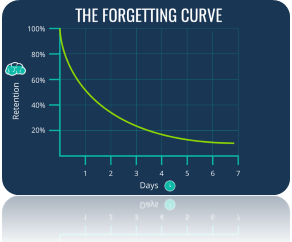The importance of retraining employees and creating an environment for learning application is essential in order to enhance the effectiveness of any training activity.
What is the best way to remember a person’s name? Many people suggest that when you are introduced to a new person, you should say that person’s name right away. It will help you remember the person’s name. Use it or lose it.
How do we relate this example with retraining in order to reinforce learning application in an organization and improve effectiveness of training?

The Forgetting Curve
The Forgetting Curve explains why we lose the information if we don’t use it. Herman Ebbinghaus, a German psychologist, developed the Forgetting Curve in the late 19th century. The graph shows that we lose approximately 90% of new information within a week. The biggest loss of learning happens in the first day. The Forgetting Curve looks something like this:

The Forgetting Curve applies to training too. When training is delivered and then not used right away, learners forget the training.
The good news is that the brain is built to retain information when it is used. Just like using a person’s name will help you remember the person’s name, if you use the training information right away – within hours of learning it, your brain will remember it.
However, many vendors in the L&D space will say the answer to the Forgetting Curve is Learning Reinforcement rather than Learning Application. Don’t buy into Learning Reinforcement as it is a Band Aid rather than a solution.
Learning Reinforcement
So, what is Learning Reinforcement? Learning Reinforcement involves sending additional information to the learner at stated intervals after the learning event. Vendors will suggest the intervals start within 24 hours of the learning event and then again 1 week later and again 4 weeks later.
The primary assumption built into learning reinforcement is that learners are not leaving learning events ready to apply the training on the job, or use the training on the job. There may be several reasons for this:
- A leader did not set the expectation that the learners apply the training on the job
- There wasn’t any clear direction on “what” the learner is expected to apply on the job
- .The learning event did not make it easy to apply the training
Learners look at the learning event whether it be an instructor led workshop or an elearning course as an event that takes place in a conference room or on their laptop and that is where it stays – in the conference room or the laptop rather than applied on the job. They go back to work, and it is “business as usual”.
How about if we look at learning events differently? How about if we focus learning events on “on the job application and on the job development”. This is Learning Application.
Learning Application
Learning Application focuses on applying the learning directly following the learning event. To do this, we need to set the stage and expectation with learners that after they complete the learning event that they apply the course on the job. How about if we make it easy for learners to walk out of the conference room or close their laptop and have something that is easy to do on the job – an exercise to help them apply the course on the job? This is Learning Application, and good Learning Application includes:
- Early on in the learning event, set the expectation that the learner will apply the learning on the job.
- Provide the learner with an exercise containing detailed step by step instructions on how to apply the course on the job
- Built in Job Aids to help the learner easily complete the exercise
- At the end of the exercise, ask the learner to reflect and think about “the next time I am going to do this the same, because that turned out awesome. And the next time, I am going to do this differently so that I have a better result.”
Asking learners to apply the learning content on the job engrains the new behavior. It defeats the Forgetting Curve and eliminates the need for Learning Reinforcement.
What could be better than providing learners with more information to reinforce learning than an exercise to help the learner apply the course on the job, engraining new behavior?
If you provide your learners with an on-the-job exercise, you are asking your learners to Use It – Don’t Lose It!
Maventra is a comprehensive Learning Management System (LMS) with FREE plans for training up to 10 employees. Please click here to register today and get access to free content as well as training platform.
